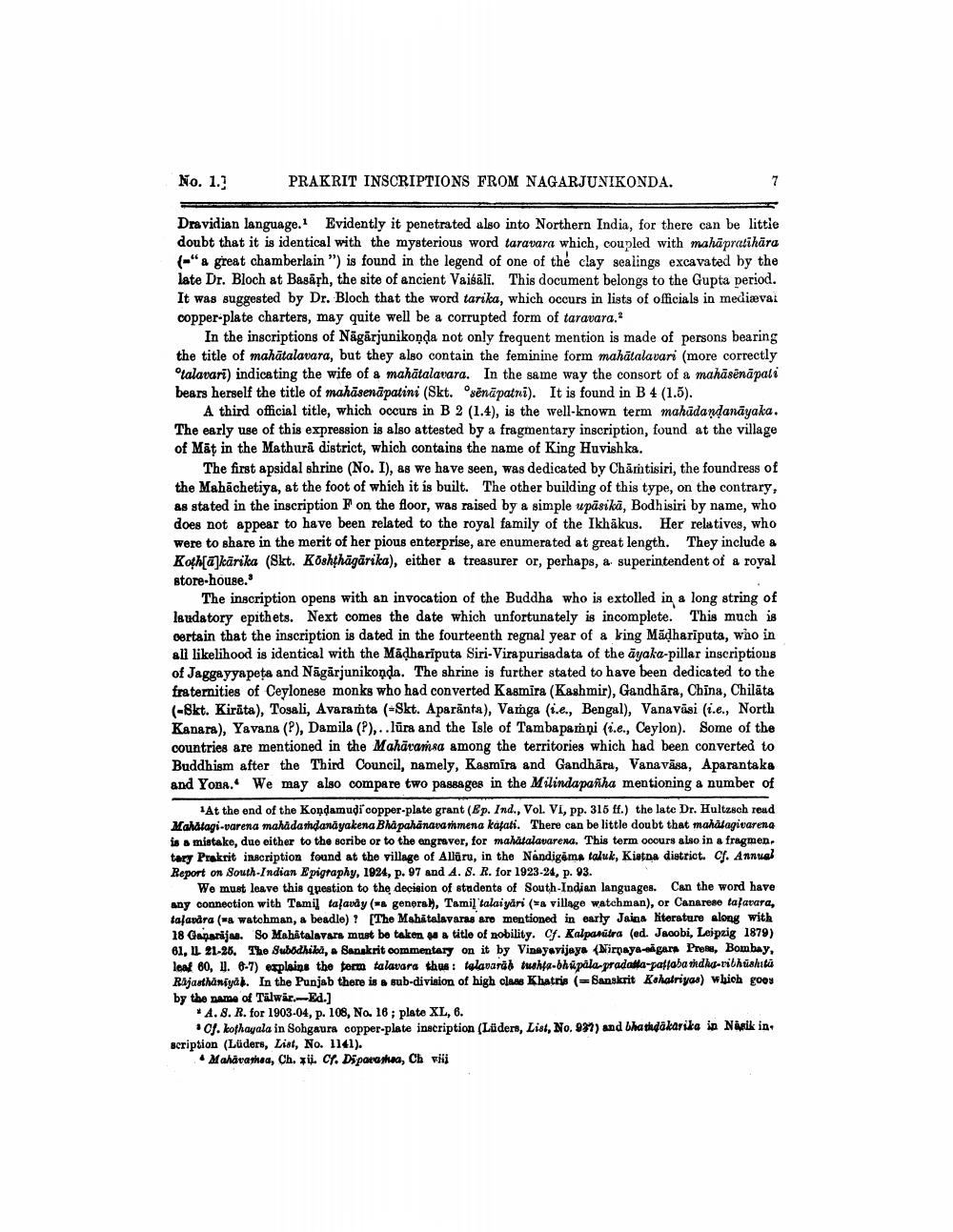________________
No. 1.7
PRAKRIT INSCRIPTIONS FROM NAGARJUNIKONDA.
Dravidian language. Evidently it penetrated also into Northern India, for there can be little doubt that it is identical with the mysterious word taravara which, coupled with mahāpratihāra (-"a great chamberlain ") is found in the legend of one of the clay sealings excavated by the late Dr. Bloch at Basăph, the site of ancient Vaisāli. This document belongs to the Gupta period. It was suggested by Dr. Bloch that the word tarika, which occurs in lists of officials in mediævai copper-plate charters, may quite well be a corrupted form of taravara.
In the inscriptions of Nagarjunikonda not only frequent mention is made of persons bearing the title of mahātalavara, but they also contain the feminine form mahātalavari (more correctly
talavari) indicating the wife of a mahātalavara. In the same way the consort of a manāsēnāpali bears herself the title of mahāsenāpatini (Skt. Osēnāpatni). It is found in B 4 (1.5).
A third official title, which occurs in B 2 (1.4), is the well-known term mahādandanāyaka. The early use of this expression is also attested by a fragmentary inscription, found at the village of Māt in the Mathurā district, which contains the name of King Huvishka.
The first apsidal shrine (No. I), as we have seen, was dedicated by Chămtisiri, the foundress of the Mahāchetiya, at the foot of which it is built. The other building of this type, on the contrary, as stated in the inscription F on the floor, was raised by a simple upāsikā, Bodhisiri by name, who does not appear to have been related to the royal family of the Ikhākus. Her relatives, who were to share in the merit of her pious enterprise, are enumerated at great length. They include & Koth[@]kārika (Skt. Köshthāgārika), either a treasurer or, perhaps, a superintendent of a royal store-house.
The inscription opens with an invocation of the Buddha who is extolled in a long string of laudatory epithets. Next comes the date which unfortunately is incomplete. This much is certain that the inscription is dated in the fourteenth regnal year of a king Madhariputa, who in all likelihood is identical with the Mädhariputa Siri-Vira purisadata of the ayaka-pillar inscriptions of Jaggayyapeta and Nagarjunikonda. The shrine is further stated to have been dedicated to the fraternities of Ceylonese monks who had converted Kasmira (Kashmir), Gandhāra, China, Chilāts (-8kt. Kirāta), Tosali, Avaramta (=Skt. Aparānta), Vamga i.e., Bengal), Vanavasi (i.e., North Kanara), Yavana (?), Damila (),..lūra and the Isle of Tambapamņi (i.e., Ceylon). Some of the countries are mentioned in the Mahāramsa among the territories which had been converted to Buddhism after the Third Council, namely, Kasmira and Gandhāra, Vanavāsa, Aparantaka and Yona. We may also compare two passages in the Milindapafiha mentioning a number of
At the end of the Kondamudi copper-plate grant (Ep. Ind., VOL. VI, pp. 315 ff.) the late Dr. Hultzsch read Mahatagi-varena mahadandandyakena Bhapahanavanmena kafati. There can be little doubt that mahalagivarena is a mistake, due either to the scribe or to the engraver, for mahätalavarena. This term occurs also in a fragmen. tary Prakrit inscription found at the village of Allāru, in the Nandigóma taluk, Kistna district. Cf. Annual Report on South Indian Epigraphy, 1924, p. 97 and A. S. R. for 1923-24, p. 93.
We must leave this question to the decision of students of South Indian languages. Can the word have any connection with Tamil ta avdy (* generall), Tamil 'talaiyari (& village watchman), or Canarese tafavara, tasavira (a watohman, a beadlo)? [The Mehátalavaras are mentioned in early Jaina Niterature along with 18 Canarijas. So Mahitalavars must be taken a title of nobility. Cf. Kalpasūtra (ed. Jacobi, Leipzig 1879) 61, L 21-26. The Subodhibi, a Sanskrit commentary on it by Vinayavijaya (Nirnaya-tigara Preru, Bombay. low 80, 11. 6-7) explains the form talavara thus : talavaral tush-bhapala-pradada-paffabandhu-vibhushitu Rajasthaniyak. In the Punjab there is a sub-division of high class Khatris (Sanskrit Kahatriyas) which goes by the name of Talwar.Ed.)
* A.8. R. for 1903-04, p. 108, No. 16; plate XL, 6.
Oj. kothayala in Sohgaura copper-plate inscription (Lüders, List, No. 997) and bhatıdakarika in Nisik in. scription (Lüders, List, No. 1141).
Mahavamsa, Ch. xii. Cf. Dipartea, Ch või




